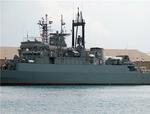Iran, Saudi Arabia in tense buildup opposite Yemen’s Gulf of Aden shore: US air tankers refueling Saudi jets
DEBKAfile Exclusive Report April 10, 2015,
Saudi-Iranian saber-rattling over Yemen has reached a dangerous peak, Thursday, April 9, the Saudi army spokesman, Brig. Gen. Ahmad Al-Assiri, warned: “Iranian ships have the right to be present in international waters, but won’t be allowed to enter Yemeni territorial waters.” This was Riyadh’s rapid-fire riposte for the Iranian decision to deploy its navy’s 34th Flotilla, consisting of the Alborz destroyer and the Bushehr helicopter carrier warship, in the Gulf of Aden opposite the Yemeni coast.
The Saudi general noted that Iran had not evacuated any of its citizens from Yemen because, he said, “they are all involved in training and arming the Houthis.”Soon after launching their air offensive in late March against the Iranian-backed Houthi rebels and forces loyal to ousted president Ali Saleh, the Saudis took control of the country’s airspace to prevent the landing of airlifted Iranian supplies for the Houthis. Russian flights were also barred later from landing in the embattled country. Gen. Al-Assiri then issued Saudi Arabia’s bluntest threat yet: “Those Iranians planning to remain in the country would face the same fate as the Houthis and their supporters,” he said.
Clearly, the Iranian Revolutionary Guards personnel were being trapped in a Saudi vice: Unable to leave Yemen, on the one hand, they were threatened with death if caught, on the other. Tehran decided to send its most effective naval force to the Gulf of Aden when it realized that Riyadh would not heed its warnings to back off Yemen. Its presence substantiated the threat of direct Iranian intervention in the Yemeni conflict should harm come to the elite IRGC force aiding the rebels. The Bushehr helicopter carrier made its maiden voyage to Port Sudan at the end of 2012. Shortly after that, on Dec. 8 of that year, DEBKAfile first revealed is features:
The new 13,000-ton vessel carries 12 Iranian strike helicopters, a crew of 200 and has a range of 8,000 nautical miles that reaches the US coast. There are five landing spots on its decks and four parking spots, as well as SM-1 and SAM anti-air missiles and 40-mm Fath-40 AAA anti-air cannon. Tehran invested $800 million in its first helicopter carrier.
If Tehran is not scared off by the Saudi threat and does order the Bushehr to sail into Yemeni territorial waters, its guns and missiles would be in range there to strike targets in neighboring Saudi Arabia to the north. Tehran could justify this attack by Yemeni President Abd Rabbo Mansour Hadi having been granted asylum in the oil kingdom.
However, the Saudi Air Force would also be on hand close by over Yemen to retaliate by bombing the Iranian Bushehr and other warships to chase them away from the Yemeni coast, if not to sink them. Our sources predict that this naval-air collision would likely be limited in extent. After peaking to a dangerous crisis, the clash would most probably be contained before it escalated into a full-blown war between Saudi Arabia and Iran.
The Obama administration’s backing for the Saudi Arabian intervention in support of the internationally recognized Yemen president Hadi was intended to keep Iran in check.
On Tuesday, April 7, US Deputy Secretary of State Antony Blinken arrived in Riyadh and stated: “Saudi Arabia is sending a strong message to the Houthis and their allies that they cannot overrun Yemen by force. As part of that effort, we have expedited weapons deliveries, we have increased our intelligence sharing, and we have established a joint coordination planning cell in the Saudi operation center.”
He was sending a clear message to Tehran backed up by solid US assistance
1. Tehran was being warned not to make the mistake of assuming that its understandings with Washington over Iran’s regional promotion included license for aggression against Saudi Arabia.
2. Tehran was notified that the Saudi operational chiefs would henceforth receive ongoing intelligence gathered by a US military satellite over the region through their joint coordination center in Riyadh. This intelligence would also cover the movements of Iranian warships in the Gulf of Aden and the Red Sea.
3. Further details of vital US aid came through Thursday, April 9, from Pentagon spokesman Army Col. Steve Warren. He announced that the US Air Force had begun an aerial refueling mission for “the Saudi Arabian-led mission engaged in air strikes on Shiite Houthi rebels in Yemen.” In its first task Wednesday, a US KC-135 Stratotanker refueled a Saudi Air Force F-15 Eagle and a UAE F-16 Fighting Falcon.
Warren said that the US Central Command aimed to fly one tanker mission a day in support of the Saudi-led alliance, but it would not enter Yemeni airspace to perform it.
Nonetheless, a potential sea-cum-air clash of arms between Saudi Arabia and Iran off the shores of Yemen cannot be ruled out, especially after Riyadh ratcheted up the tension Friday with a ban imposed on Iranian flights carrying pilgrims to Mecca.
It would not be the first firefight to be triggered by the Yemeni conflict. Earlier this week, Egyptian and Iranian warships exchanged fire in the tussle for control over the strategic Bab el-Mandeb Strait. The episode ended with the Iranian ships being ordered directed from Tehran to break off contact and distance themselves from the Egyptian craft. The Iranian Navy commander Rear Adm. Habibollah Sayyari later denied reports appearing in the Gulf media that Egyptian warships had forced Iranian naval vessels to retreat and quit the Gulf of Aden. The incendiary tension around the Gulf of Aden and rising fear of a Saudi-Iranian military engagement has raised enough alarm for the US, French and British fleets with a naval presence in the Gulf to go on a state of preparedness.





















